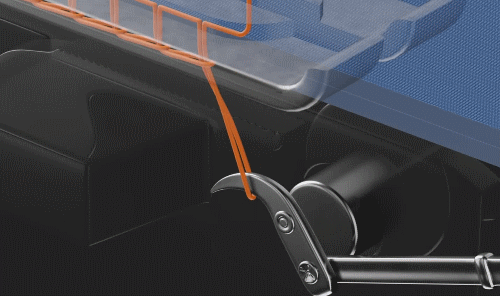We use cookies to make your experience better. To comply with the new e-Privacy directive, we need to ask for your consent to set the cookies. Learn more.
How does an overlocker form a stitch, while using different threads?
One of the most clever and simple stitches an overlocker can sew, must be the chain stitch. Its clever because it only uses one thread to form a stitch, that can attach two pieces of material together.
One thread interlinks with itself in the shape of a chain under the fabric and has the stitch formation, similar to that of knitting. Structurally, if the end of the interlinked stitch is removed, the seam will continue unravelling. The end stitch must be tied in correctly to stop it unravelling.
How can it chain stitch using only one thread?
- The chain stitch uses only a single thread, through one needle eye.
Once threaded, as the needle moves to its lowest point and moves up, the thread is loosened as the needle moves slightly from the lowest point and the looper catches the looped needle thread. When the needle comes down, it enters into the thread loop, which is extended by the looper.
The needle comes out of the fabric and the fabric is forced rearward. The looper rotates and releases the thread caught previously, whilst drawing the needle thread. The needle bar continues to move up and the thread take up lever pulls up the needle thread.
The looper continues its rotation drawing the thread to the central part of the looper, fastening the thread that was previously removed.
As the fabric feeding finishes, a stitch is formed and the needle penetrates the fabric again. The process returns to the first step and continues. Remember it is only using one-thread, through a single needle eye.
Slow-motion video animation showing how chain stitch is formed.

Now lets use 4, or even 5-threads with up to 3 loopers?
If you think that is complex, lets see if we can explain how the overlocker uses four or five-threads, two-needles and two, or three-loopers to form a proper overedging stitch, whilst cutting off the raw fabric edge and moving the fabric, all at the same time.
Before we watch the video below, the important piece of information I will leave you with, is some loopers can move in 3 directions. Up/ down, left/right, front/rear. Hence, a looper can move in a circular motion around a needle, which will allow it to catch the thread from the rear of the needle eye, a milli-second later, offload the thread to a second looper via the loose thread loop. Fractions of a second later, a second needle thread, interracts with the first looper, to catch the thread, when the loopers and needles return to their starting position. The threads are pulled taut with the help of the tensions to form the perfect overlock stitch.
The video animation below will give you a good understanding of how a 3 thread overlock stich is formed in slow motion.
The main stitch types are:
- 1 x Needle – 1 thread - Chain stitch
- 1 x Needle – 2 thread overlock - Edging and rolled hems on finer fabrics
- 1 x Needle – 3 thread overlock - Edging and rolled hems
- 2 x Needle – 4 thread overlock - 2-seam overlocking with stronger seams
- 2 x Needle – 5 thread overlock - Interlocking (chain + overedge)
- 2 x Needle double chain stitch - Cover stitching (2 thread cover stitch machine)
- 3 x Needle double chain stitch - Triple cover stitching (2 or 3 thread cover stitch machine)






